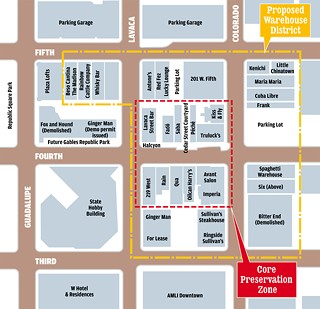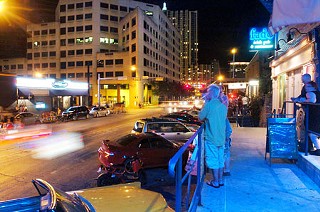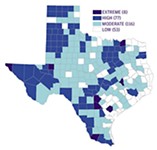Can This District Be Saved?
The Warehouse District's revival is rooted in Austin's history – and its popularity is also its peril
By Katherine Gregor, Fri., Sept. 11, 2009
It's Friday night, and Downtown's Warehouse District is hopping. Live music pours out of the Cedar Street Courtyard, as a quartet of blond, twentysomething women strut by in heels, laughing amid the simmering street life along Fourth Street. The varied restaurants and rainbow of bars and clubs attract a well-dressed pedestrian parade. By day, the smallish district also draws a thriving lunch, salon, and coffeehouse crowd. People are attracted to the district, perhaps unconsciously, because it feels authentic. Its character is inseparable from the quirky old brick warehouse buildings; the one-story, human scale; and the elevated sidewalks (built a century ago as warehouse loading docks) that make this place unique and real.
Yet no protections are in place to ensure that the Warehouse District is preserved. As Downtown thrives, the area is under increasing redevelopment pressure. While the fragmented ownership of the many small tracts offers a certain protection from redevelopment, no single building has (or has even applied for) protective historic landmark status, nor is the district as a whole on the local or national historic registers. Razed most recently were the large, iconic warehouse buildings that last housed two popular bar-restaurants, the Bitter End and Fox and Hound. Now they're just empty parking lots, slated for redevelopment as, respectively, a Westin Hotel (to be designed by Lake|Flato Architects) and Gables Republic Park, a 16-story apartment tower. In addition, Gables obtained a city demolition permit to partially tear down the handsome 1913 Nabisco warehouse that for the past 15 years housed the Ginger Man.
To stave off more bulldozing, new recommendations on methods to preserve the district recently came forward as part of the Downtown Austin Plan. The tools proposed by consultants ROMA Design Group and HR&A Advisors have sparked much debate among district property owners and among groups including the Heritage Society of Austin (originally opposed, now in support), the Downtown Austin Alliance (supportive in concept, not on the specifics), the Central Texas Chapter of the Congress for the New Urbanism (which hosted a forum), the Downtown Austin Neighborhood Association, and the city's Design, Planning, and Downtown commissions. ROMA's recommendations were publicly presented to City Council on July 23. (They're within the Final Draft Density Bonus Program report, online at www.cityofaustin.org/downtown.) The issue is scheduled to go to council again on Sept. 24. Members may provide policy direction and could vote on directing staff to draft a Density Bonus ordinance, with special warehouse district rules.
Understandably, many property owners oppose in principle any mandatory preservation tool that limits their property rights. For that reason, ROMA has recommended conferring some new development rights to compensate. Now the community as a whole needs to weigh in, before council votes, on whether district preservation is merited – and whether the tools proposed will work.
A Century of Uses
Early 20th century industrial buildings once stretched all the way from I-35 to MoPac, along the freight rail lines running between Third and Fourth streets. Only the Warehouse District has survived as a significant cluster. Downtown has few remaining areas that preserve its history and the character of past eras, ROMA has pointed out. According to their report, "The area has evolved into a unique restaurant and entertainment district and contributes to the vitality and destination appeal of the downtown. It is also one of the downtown's most significant venues for live music." A magnet for Downtown living, the district also supports the desirability and resulting property value of hundreds of surrounding condos and apartment homes, with hundreds more going up or planned. Aligned with Austin's sustainability goals, the district encourages thousands of Downtown workers, residents, and visitors to walk, bike, or use public transit instead of driving.
A storied past belongs to each building and to the district as a whole. For many years, it was a red-light district known for its bordellos, or "female boarding houses." (Oilcan Harry's was one.) City Historic Preservation Officer Steve Sadowsky assembled for the Downtown Commission and CNU an interesting slide show of historic site maps and the buildings' successive incarnations. It's fun to recognize the familiar forms of today's clubs and restaurants, surrounded by horse-drawn wagons or Model T Fords. The 1928 Purity Feed warehouse, for example, was for many years Ruta Maya and today is Halcyon – feeding urbanites lattes and panini. The energetic Antone's nightclub resides in a 1919 Exide Battery building; next door, the Lucky Lounge building began life in 1920 as the Star Supply Company. La Zona Rosa was built as a Standard Brands warehouse (circa 1926); Truluck's was the corner Merchants Transfer warehouse (circa 1912-1915). The Austin Children's Museum building was originally the OK Garage (circa 1925).
Longtime Austinites will recall the district as being industrial well into the 1970s. Pioneering gay bars transformed the still-rough area into an edgy entertainment district in the 1980s. Black + Vernooy, an architecture and urban design firm, seeded the area's renaissance in 1979, when it moved into the old Fine Papers warehouse (circa 1913). The architects renovated it and another early 20th century warehouse to create the award-winning Cedar Street Complex in 1981. While architect Sinclair Black always believed the old warehouse buildings would one day be razed for new development (he sold his a few years back), he recently said he'd be delighted if preservation comes to pass.
Interestingly, Black points out, it was a void that created the Warehouse District as we now know it. The architects preserved and excavated an empty space between buildings to create a sunken, open-air courtyard planted with trees – now an outdoor music venue for Cedar Street Courtyard. Black said that pleasant, tree-shaded place provided a magnet for all the surrounding adaptive reuse that followed. In a sense, it offers a metaphor for the Warehouse District as a whole. Its low-rise brick buildings have attracted a ring of new residential high-rises and hotels – bringing desired density to Downtown but not in the warehouses themselves. If they are torn down to make way for yet more high-rises, would that kill the goose that laid the golden egg? "The irony is that the district is so at risk because it's so attractive – people want to do new developments in it and close to it," said Jacqui Schraad, executive director of the Heritage Society. For example, the planned 18-story Westin Hotel will market itself as a chic "Warehouse District hotel"; yet to make way for it, the warehouse that housed the Bitter End (which closed after a 2005 fire) was demolished.
Transfer of Development Rights

The ROMA team has recommended to council new policies and ordinances that would create an official, two-tiered Warehouse District. For the whole area, they recommend pursuit of protective historic landmark status where possible, mandatory design standards to ensure compatible new development and renovations, and use of a tool successfully used by other cities, transfer of development rights (see "How Does TDR Work?").
The TDR principle: Much of the value in a property lies in its zoning entitlements, which confer development rights up to a certain height/density. By allowing an owner to sell, or transfer, those entitlements separately from the property, a city allows owners to make good money yet preserves existing uses and buildings by deed-restricting the land in perpetuity. It defuses the argument that down-zoning and preservation requirements constitute a "taking" of private property rights, because the owner receives something of equal or greater real-estate value in return.
Currently, all properties within the proposed Warehouse District boundaries (none of which are height-restricted by Capitol view corridors) are entitled to an 8:1 floor-to-area ratio – the floor-to-area ratio that produced, for instance, the Frost Bank Tower. But in order to realize the full property value, owners would have to tear down the warehouses. (Most are generating a tidy lease income, as is.) If council enacts TDR, owners could sell just their development rights, transferring that unused density to developers seeking it for projects elsewhere Downtown. The overall density bonus program proposed makes TDR worth up to $10 per square foot. Owners selling their "air rights" potentially would make even more money; the density would stay within the boundaries of Downtown – and Austin gets to retain the character of its Warehouse District.
The ROMA team further recommends that the most significant cluster of intact warehouses – the same block on Fourth Street between Lavaca and Colorado pioneered by Black + Vernooy – get special protections as a "Core Preservation Zone" (see map). Only on this one block, a 45-foot height limit would apply, back to the alleys. Michael McGill, who has worked to negotiate consensus in the debate as a member of the Downtown Austin Neighborhood Associa-tion, the Heritage Society of Austin, and the Congress for the New Urbanism – he was just appointed to the Downtown Commiss-ion, as well – believes that's a necessary measure to actively protect more warehouses from becoming teardowns. In compensation for this down-zoning, property owners in the core zone would be granted far more development rights to transfer: up to a 25:1 floor-to-area ratio, rather than 8:1.
Landmark Status
But the Downtown Austin Alliance, whose voting board consists solely of property owners, does not support the height limit. Its members are dubious about the Austin market for transferred development rights.
"Everybody thinks the Warehouse District is a valuable amenity for Downtown and would like to see it remain intact," said DAA Executive Director Charlie Betts. "But they object on principle to the precedent of down-zoning property." He also points out that within the proposed boundaries, Warehouse District sites have 1.4 million square feet of unused floor-to-area ratio.
Instead, the DAA says, property owners can voluntarily seek city historic landmark status for the entire district or for their buildings. (If one building were landmarked near the middle of each half-block, it would neatly kill the potential to aggregate a large tract for redevelopment.) That would offer the most sure and direct path to preservation, agreed Shraad, by requiring that any modification or demolition requests must go before the city's Historic Landmark Commission. But she said no owner has ever applied, and it's been assumed the district as a whole would never find the majority owner support required. City Council voted Aug. 6 to ease the rules for creating local historic districts; now owners of 51% (rather than 60%) of the designated acreage would have to agree to set the proposal in motion.
Sadowsky and his staff have been researching which properties might qualify for historic zoning. Of course, the historic preservation office already decided that the Ginger Man warehouse isn't architecturally significant, allowing a demolition permit to be issued for it. (It's still there, for now.) The Heritage Society plans to approach owners of properties on the list, pitch the benefits of historic zoning (which include a partial property-tax abatement), and encourage them to seek landmark status. The group has also begun an online petition drive at www.savethewarehousedistrict.com. "We feel a sense of urgency as the Downtown Plan is getting put in place," said Shraad.
"It would be great if we could turn it all into a local historic district; I think it would definitely qualify for that," she added. Like ROMA's Jim Adams, she noted that as a cluster, the warehouses have special historic value, apart from the architecture of any single building. That's a view shared by many signers of the online Heritage Society petition, who express regrets about what's already been lost and how fast Austin is changing. As native Austinite Joanne Riley put it: "So many things that I remember from my childhood are now gone (especially in the downtown area). Please do not let any more history be destroyed." One way or another, the Heritage Society stated in a letter to City Council, "Surely our city can manage to direct development of these few blocks in a way that preserves the very essence of what makes Austin such a popular destination."
To see more historic photos of the Warehouse District, along with current-day incarnations of many of the buildings, see "Then and Now" and "Scenes From the Warehouse District" with this article online at austinchronicle.com.
Got something to say on the subject? Send a letter to the editor.










